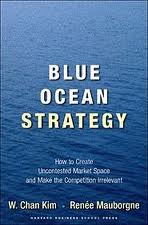Blue Ocean Strategy: How to Create Uncontested Market Space and Make the Competition Irrelevant

– By W. Chan Kim and Renee Mauborgne
Blue Ocean Strategy, W. Chan Kim and Renée Mauborgne’s best-selling 2005 book, is a great read. It has a very appealing sub-line: ‘How to Create Uncontested Market Space and Make the Competition Irrelevant.’ Now which one of us wouldn’t want to do that!
In the book, Chan Kim and Mauborgne of INSEAD have built a compelling case for creating new demand in an uncontested market space (a Blue Ocean) rather than competing directly with other competitors in an existing market (a Red Ocean).
Based upon the book, Wikipedia describes red oceans and blue oceans thus: red oceans are all the industries in existence today – the known market space. In the red oceans, industry boundaries are defined and accepted, and the competitive rules of the game are known. Here companies try to outperform their rivals to grab a greater share of product or service demand. As the market space gets crowded, prospects for profits and growth are reduced. Products become commodities or niche, and cutthroat competition turns the ocean bloody; hence, the term red oceans. In contrast, blue oceans denote all the industries NOT in existence today – the unknown market space, untainted by competition. In blue oceans, demand is created rather than fought over. There is ample opportunity for growth that is both profitable and rapid. In blue oceans, competition is irrelevant because the rules of the game are waiting to be set. Blue Ocean is an analogy to describe the wider, deeper potential of market space that is not yet explored.
It was Coca Cola’s legendary head, Robert Goizueta who had once said: ‘In real estate, it’s location, location, location. In business it’s differentiate, differentiate, differentiate.’ Almost all the great marketing thinkers – including Michael Porter – have written and spoken about the importance of differentiating your company/product/brand from those of others; to that extent, Chan Kim and Mauborgne aren’t really saying anything that we all don’t know about or believe in. However, they have come out with a pretty good framework for creating businesses and brands in an UNCONTESTED market.
Let’s examine some of the key points that have been raised in Blue Ocean Strategy:
- Companies should increasingly be looking at creating demand in new market spaces rather than go about fighting each other head to head. The authors feel that this has happened due to business strategy borrowing too much from military concepts and jargon; after all, the whole idea of a war is to win over the competing army.
- Value Innovation: This is the cornerstone of Blue Ocean Strategy – the simultaneous pursuit of differentiation and low cost. According to Chan Kim and Mauborgne, ‘Value Innovation is created in the region where a company’s actions favourably affect both its cost structure and its value proposition to buyers. Cost savings are made by eliminating and reducing the factors an industry competes on. Buyer value is lifted by raising and creating elements the industry has never offered. Overtime, costs are reduced further as scale economies kick in due to the high sales volumes that superior value generates.’
- The four principles for formulating a Blue Ocean Strategy: (a) Creating uncontested market space by reconstructing market boundaries. The book argues that there are clear patterns for creating blue oceans; there are six basic approaches to remaking market boundaries (that they call the Six Paths Framework); (b) Focusing on the big picture. In the book, the authors argue that a company can reduce its planning risk by following the four steps of visualising strategy (Visual Awakening; Visual Exploration; Visual Strategy Fair; Visual Communication); (c) Reaching beyond existing demand. Rather than looking at existing customers, companies should look at non-customers and create demand by unlocking the three tiers of non-customers; (d) Getting the strategic sequence right. ‘Companies need to build their blue ocean strategy in the sequence of buyer utility, price, cost, and adoption.
- The two key implementation principles of Blue Ocean Strategy: (a) Tipping point leadership that would allow leaders to overcome the four key organizational hurdles that can prevent strategies from being executed; (b) Fair process. If fair process is not followed, there is a strong likelihood of a faulty execution of the strategy. The authors outline the three E principles of fair process – engagement, explanation and clarity of expectation.
The book gives some good examples of businesses that have identified blue oceans and succeeded in them – Cirque du Soleil, Southwest Airlines, yellow tail, NetJets, NTT DoCoMo and others.
Chan Kim and Mauborgne’s theory, though interesting and well-articulated, has a major shortcoming: There are very few examples of companies that have succeeded using Blue Ocean Strategy. The companies used in the book as examples have possibly been retrofitted. There is only one example – the Nintendo DS handheld game system – of a brand that was developed using the principles of Blue Ocean Strategy.
Blue Ocean Strategy is, possibly, a great branding exercise of already existing concepts and frameworks. Having said that, there is no doubt that Chan Kim and Mauborgne have written a book that presents an idea that has immense appeal to strategists and marketers. It also presents a thorough framework to try and genuinely look at blue oceans. Hopefully, we will soon have more examples of companies that have succeeded by following the principles outlined in Blue Ocean Strategy.
Rating: A
